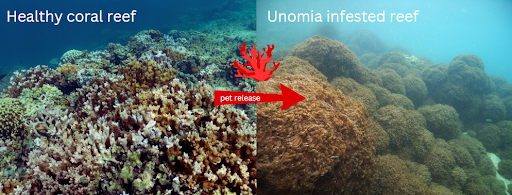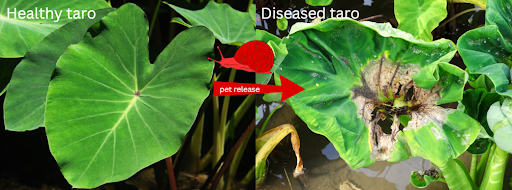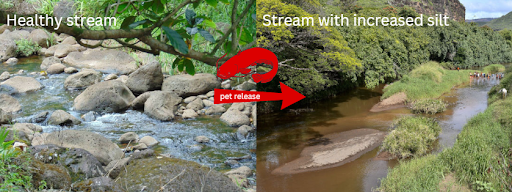History of Aquatic Pet Releases in Hawaiʻi
Notable Aquatic Releases
Explore this interactive map to discover where a few notable aquatic pets have been found in Hawaiʻi.
Consequences of releasing your pets
Unomia stolonifera is a soft-octocoral native to the Indo-Pacific that has devastated coastal ecosystems in Venezuela since its introduction in the 90’s. First discovered in Pearl Harbor in 2019, it poses a significant threat to Hawaii’s coral reefs. This species is popular in the aquarium trade and is believed to have been introduced to Pearl Harbor through an aquarium release. This soft coral is capable of overgrowing and smothering native stony corals, decimating fish populations, and releasing a foul, fishy scent across the coastline. Unomia is a prime example of why it is important to dispose of unwanted pets responsibly through an amnesty program and never introduce non-native species to the environment.

The apple snail (Pomacea canaliculata) is a freshwater pest commonly found in slow-moving water bodies including rice and taro fields, ponds, ditches, wetlands, and streams. Native to South America, its spread is believed to have occurred through the aquarium industry. These snails damage taro crops by chewing through the corms, creating entry points for pathogens, which severely reduce crop yield and quality. They also consume young taro shoots. In natural ecosystems, apple snails disrupt habitats by eating plants essential for native fish and birds. Additionally, they are vectors for rat lungworm and other parasitic diseases, posing significant risks to both human health and agriculture in Hawaiʻi and beyond.

The armored catfish, a popular ornamental species native to northern South America, can grow up to 50 cm and is covered in protective armored plates. These fish thrive in quiet, slow-moving waters and are often found in shallow areas of lakes, rivers, and reservoirs. In Hawaiʻi, they were introduced through aquarium releases and are currently present on O‘ahu and Maui. This invasive species competes with native fish for food and habitat, and their burrowing behavior contributes to increased erosion and sedimentation, further degrading aquatic environments.
